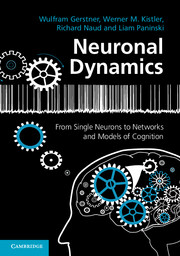Book contents
- Frontmatter
- Contents
- Preface
- PART ONE FOUNDATIONS OF NEURONAL DYNAMICS
- 1 Introduction: neurons and mathematics
- 2 Ion channels and the Hodgkin–Huxley model
- 3 Dendrites and synapses
- 4 Dimensionality reduction and phase plane analysis
- PART TWO GENERALIZED INTEGRATE-AND-FIRE NEURONS
- PART THREE NETWORKS OF NEURONS AND POPULATION ACTIVITY
- PART FOUR DYNAMICS OF COGNITION
- References
- Index
3 - Dendrites and synapses
Published online by Cambridge University Press: 05 August 2014
- Frontmatter
- Contents
- Preface
- PART ONE FOUNDATIONS OF NEURONAL DYNAMICS
- 1 Introduction: neurons and mathematics
- 2 Ion channels and the Hodgkin–Huxley model
- 3 Dendrites and synapses
- 4 Dimensionality reduction and phase plane analysis
- PART TWO GENERALIZED INTEGRATE-AND-FIRE NEURONS
- PART THREE NETWORKS OF NEURONS AND POPULATION ACTIVITY
- PART FOUR DYNAMICS OF COGNITION
- References
- Index
Summary
Neurons have intricate morphologies: the central part of the cell is the soma, which contains the genetic information and a large fraction of the molecular machinery. At the soma originate long wire-like extensions which come in two different flavors. First, the dendrites form a multitude of smaller or larger branches on which synapses are located. The synapses are the contact points where information from other neurons (i.e., “presynaptic” cells) arrives. Second, also originating at the soma, is the axon, which the neuron uses to send action potentials to its target neurons. Traditionally, the transition region between soma and axon is thought to be the crucial region where the decision is taken whether a spike is sent out or not.
The Hodgkin–Huxley model, at least in the form presented in the previous chapter, disregards this spatial structure and reduces the neuron to a point-like spike generator – despite the fact that the precise spatial layout of a neuron could potentially be important for signal processing in the brain. In this chapter we will discuss how some of the spatial aspects can be taken into account by neuron models. In particular we focus on the properties of the synaptic contact points between neurons and on the electrical function of dendrites.
Information
- Type
- Chapter
- Information
- Neuronal DynamicsFrom Single Neurons to Networks and Models of Cognition, pp. 58 - 80Publisher: Cambridge University PressPrint publication year: 2014
